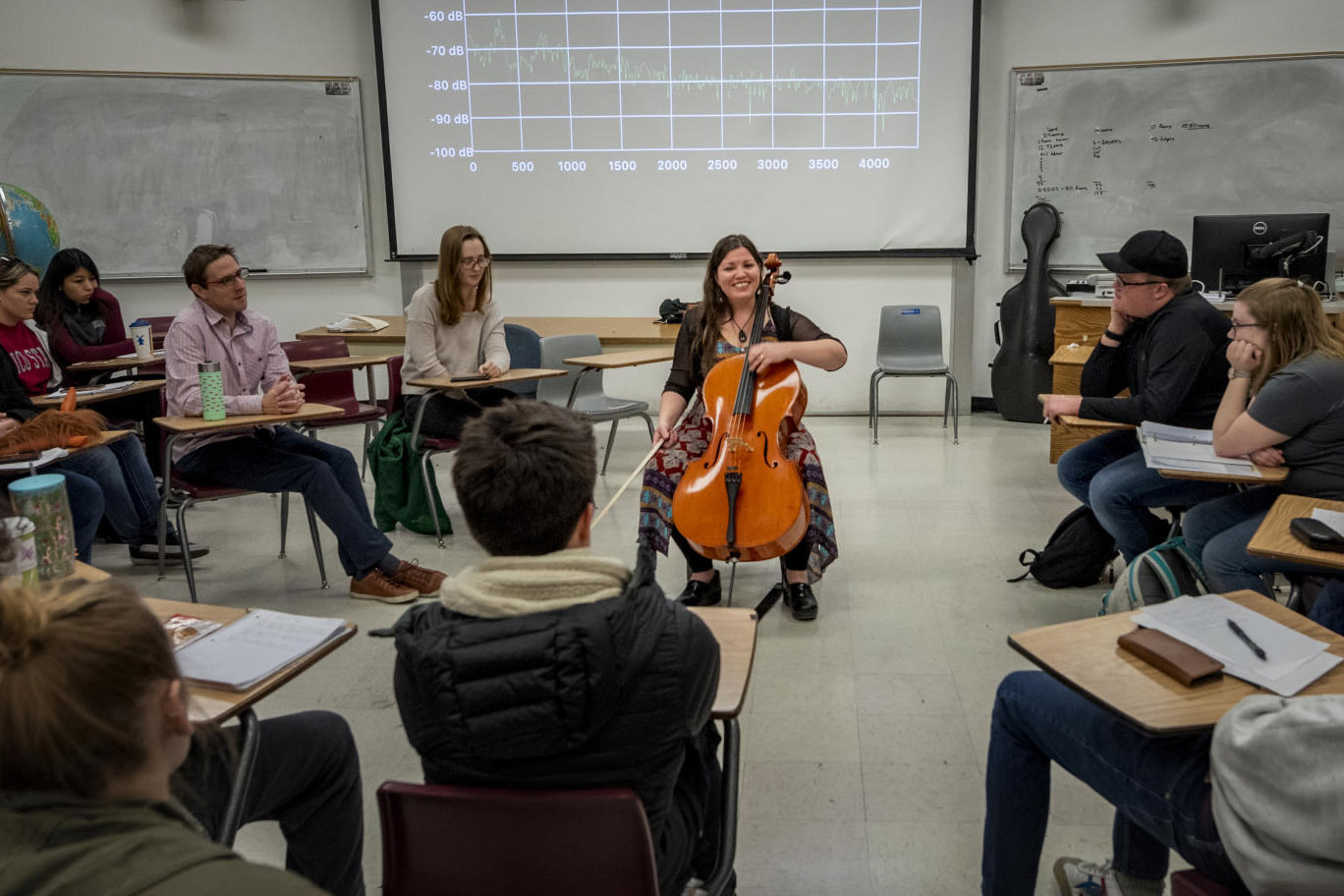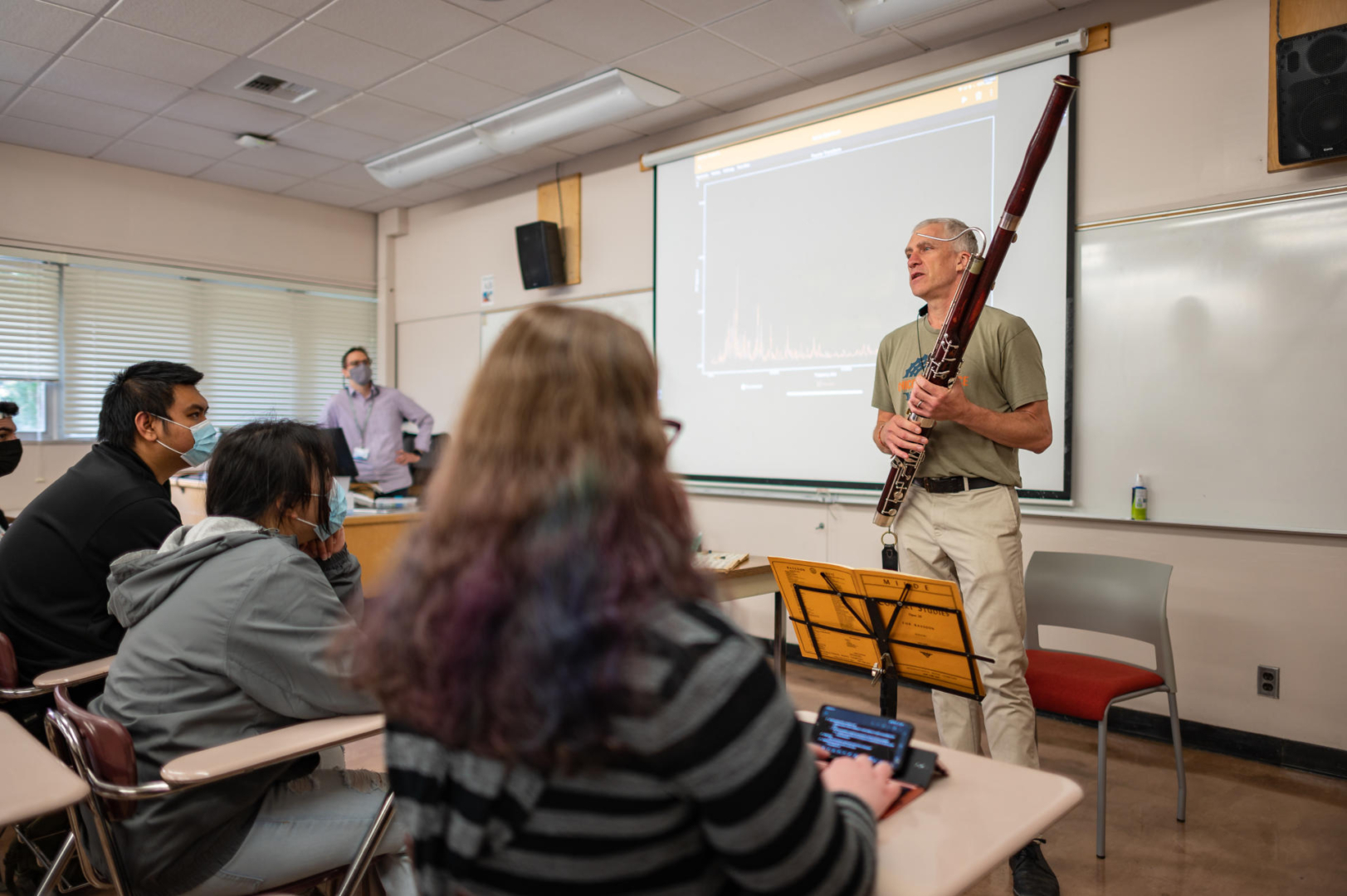Crash Course: Physics of Music

Cellist Rebecca Hood (center) performs on the cello for students in Physics of Music, PHYS 309 class as they learn about frequencies on Thursday, October 31, 2019 in Chico, Calif. (Jason Halley/University Photographer/CSU Chico)
In brainstorming ways to entice more students to study physics, faculty Joseph Pechkis discovered he could hitch his teaching to a topic nearly everyone enjoys: music. Because whether you draw a bow along a violin string, strike a drum, or strum a guitar, the two disciplines are inextricably linked, as vibrations and sound work in perfect concert together.
“The physics of music is the physics of waves,” he said. “And what I really want to teach students is that, yes, modern physics is the physics of waves but also quantum physics and quantum mechanics.”
Lofty expectations? Perhaps. But Pechkis’ approach appears to be working—his class “Physics of Music” is increasing in popularity—not just from recording arts, music, and physic majors, but many studying communication sciences and disorders, too. Throughout the course of the semester, students gain a deeper understanding of both topics as he teaches students how each sound produces unique waves depending on instrument, pitch, and tone.
“The idea is to build some understanding of physics by looking at something they know and enjoy,” he said. “Everybody enjoys music, but not everybody enjoys physics as much—so I introduce my students to these concepts, and hopefully they get a deeper appreciation for physics from it.”

Pechkis, who received the Outstanding Lecturer Award as part of the University’s 2020–21 Outstanding Faculty Awards, begins the course each semester with no assumption his students have any knowledge of either discipline—only that they are come in with open minds.
Bjorn Larsen (Physics, ’21) said taking the class during his final semester this spring was an easy choice, as he was eager to understand the connections between both two subjects he loves on a deeper level. He recommends any student with an interest in either topic consider taking Pechkis’ class, adding that the physics material is taught in a way that is palatable and not intimidating, regardless of the student’s background.
“I think oftentimes students are pushed away from physics because they take a physics class and get steamrolled by all the math you have to do,” he said. “‘Physics of Music’ contains only a very minimal amount of math, just enough to understand the very basics of sound and vibrations. From there, instead of using math, one uses their understanding of music as the tool to understand topics across the whole of physics, such as spectroscopy, earthquakes, MRI, and gravitational waves—if you take this class and come with an open mind, you will definitely be rewarded.”
Of course, a class related to music would not be complete without the sounds themselves. In nearly every class, Pechkis presents music of some kind, whether recorded or live—he plays guitar and keyboard in-class, although he said he wouldn’t consider himself a “musician”—to demonstrate aspects like musical intervals, scales, chords, and basic chord progressions, which are the basis of American music. In doing so, he also demonstrates how a composer employs different intervals and chords to create consonance (pleasing sounds) and dissonance (tension or sounds that are not pleasing).
“I try to really be conceptual with it, but I start by asking, ‘why do certain notes sound good?’” he said. “There are certain notes and scales that are universal throughout different cultures and we explore those.”
Adding music from Java, India, and the Middle East—all of which have very different foundations and may sound unfamiliar—students begin to see and hear differences in the sound, tones, and scales. For example, the traditional Western scale has 12 notes—we primarily use seven—while the Indian musical scale has 24 notes.
While Pechkis plays recordings of music for the class, live musicians often elicit the strongest reaction, providing performances and demonstrations by Bach, Mozart, Rachmaninoff, and Ravel. Live musicians have included physics colleague and resident bassoonist David Brookes, cellist and Yuba College fine arts faculty Rebekah Hood, and Sam DeCaprio—a C.V. Starr Doctoral Fellow and cellist from The Julliard School.
As students sit captivated by the performers, Pechkis often feal like he has realized his goal: making physics fun and interesting for every one of his students.
“I hope that students can see the relevance of going from music to physics and science—and how they influence each other,” Pechkis said. “Students get a broad picture of how they seemingly were studying music, but I was actually teaching them physics all along.”


